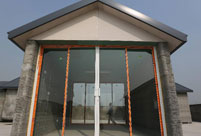 Ni Ni covers BAZAAR JEWELRY
Ni Ni covers BAZAAR JEWELRY
 Cherry blossoms reach peak bloom in Washington D.C.
Cherry blossoms reach peak bloom in Washington D.C.
 Top Chinese fashion icons in foreigners' eyes
Top Chinese fashion icons in foreigners' eyes
 Asia's largest business aviation exhibition to be held in Shanghai
Asia's largest business aviation exhibition to be held in Shanghai
 World's top-rated luxury hotels
World's top-rated luxury hotels
 Wu Jing, Xie Nan to hold wedding on May
Wu Jing, Xie Nan to hold wedding on May
 London Cake International attracts tourists
London Cake International attracts tourists
 Let's dance in harmonic Shaanxi
Let's dance in harmonic Shaanxi
 Christie's to auction dazzling diamonds
Christie's to auction dazzling diamonds
 'Model husband' shatters image of love
'Model husband' shatters image of love
SHANGHAI, April 18 -- The Yangtze Delta, China's entrepreneurial heartland, has been hit by a new surge in office vacancies.
The stock of prime office space in Shanghai hit 6.31 million square meters in 2013 and will double in the next two to three years based on property consultancy DTZ's estimate. In contrast, annual demand for such space has stood at less than 900,000 square meters since 2010 and shows no sign of picking up in the near term.
An investment binge over the years has created a glut that will take at least a decade to fill, hurting some developers' margins while leaving others insolvent.
Over the years, skyscrapers have risen up one after another to dominate the skyline in east China's Jiangsu, Zhejiang and Shanghai, cities whose combined economic output accounts for a fifth of the nation's total.
However, the demand is yet to catch up with the pace of building in the region amid a slowing economy.
While real estate has long been an effective way for local government to shore up growth, developers have felt the pinch between rising land prices and weakened demand.
But this has not bucked the trend of fast growth of office buildings in the region. According to DTZ, the stock of commercial property grew at 10 percent in each of the past three years in Shanghai and that rate is expected to accelerate to 30 percent in the next three years.
While overall supply exceeds demand, analysts say commercial properties have not been built in places where they are most wanted, making it all the more difficult for developers to rent them out.
Zhou Zhifeng, an analyst with Jones Lang LaSalle, said the next two years will see another wave of new offices in Shanghai, most of which will be on the west side of the Huangpu River, in areas previously occupied by factories and industrial warehouses.
Yet across the river, the Pudong New District, where Asia's tallest skyscraper is under construction, still boasts an enviable vacancy rate below 10 percent, a sign that companies still crave plots in an established center with a well-connected transport grid and other world-class infrastructure.
In Taihu, a county under the ancient city of Wuxi 141.6 km from Shanghai, some developers face a liquidity drought. "Some offices are leased out at a price lower than the cost of land," Zhou said.
In Hangzhou, the provincial capital of Zhejiang, vacancies in a central business district built three years ago southeast of the old downtown still hover around 30 percent. According to real estate consultancy CBRE, it will take at least another two years to fill these empty offices, assuming the 15 percent a year occupancy rate recorded in the past three years.
Zhou said the building binge in tier-2 and tier-3 cities has resulted in many white elephant projects -- empty offices in the middle of nowhere. The lack of all-important transportation and other infrastructure makes these office buildings unappealing to companies.
"This has built up some risks for developers. Without sufficient occupancy, developers may have trouble keeping their cash flow," according to Zhou.
However, analysts say the long-term trend could improve if China's economy grows more on the back of its service sector. Jones Lang LaSalle said that as long as the tertiary sector such as financial services, professional services, medical care and retail demonstrate robust growth, and Chinese companies continue to evolve globally, demand will eventually rise on a par with prime office supply, with vacancy rates in the city expected to temper to below 10 percent in 2020.
 Children in ancient costumes learn Zhusuan
Children in ancient costumes learn Zhusuan Tens of thousands celebrate Water Splashing Festival
Tens of thousands celebrate Water Splashing Festival A bite of China II whets the appetite
A bite of China II whets the appetite Chinese frigate completes its 14th escort mission
Chinese frigate completes its 14th escort mission Let's dance in wealthy Shaanxi
Let's dance in wealthy Shaanxi A date with 798: feel the art around you
A date with 798: feel the art around you 3D-printed houses built in Shanghai
3D-printed houses built in Shanghai World largest scale of umbrella dance
World largest scale of umbrella dance Cherry blossoms reach peak bloom in Washington D.C.
Cherry blossoms reach peak bloom in Washington D.C. The backstage of the Fashion Week
The backstage of the Fashion Week College students in Han costumes
College students in Han costumes Postgraduate works as waitress
Postgraduate works as waitress Life in a Lahu village in Yunnan
Life in a Lahu village in Yunnan An orphan’s wedding
An orphan’s wedding Hollywood documentary brings Diaoyu Islands truth to new audience
Hollywood documentary brings Diaoyu Islands truth to new audienceDay|Week|Month